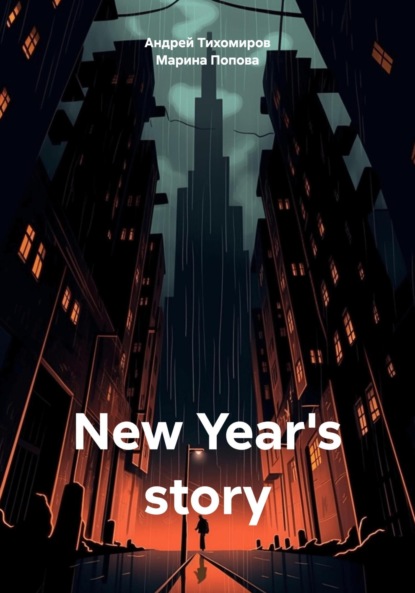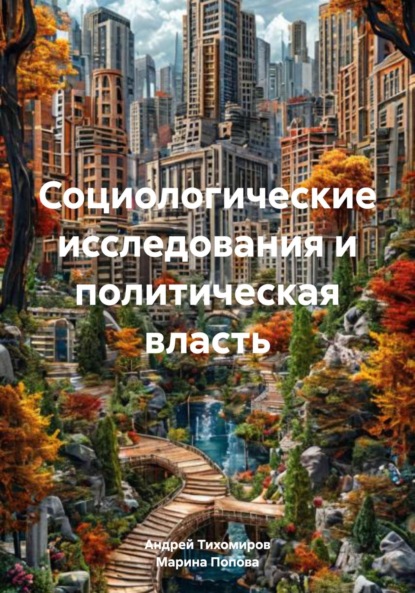
Полная версия:
Марина Попова New Year's story
- + Увеличить шрифт
- - Уменьшить шрифт

Андрей Тихомиров, Марина Попова
New Year's story
The concept of the New Year and its history
New Year is the time or day on which a new calendar year begins and the number of years in the calendar increases by one. Many cultures celebrate this event in one way or another. According to the Gregorian calendar, the most widely used calendar system today, the New Year falls on January 1st.
Since ancient times, the New Year has been celebrated as a universal one, and with the strengthening of state power, as a public holiday. At the same time, the New Year has always been perceived as a family holiday, as a holiday that connects each person with his relatives, with living and deceased ancestors. In the celebration of the New Year there were, and still exist to this day, several levels: state and national, public and family. The main attributes of any year are the alternation of day and night, their return again to their original positions. That is, we are talking about the winter and summer solstices, the spring and autumn equinoxes. These moments of the year were celebrated by ancient peoples as a kind of beginning. The movements of the Sun and Moon are the most prominent, regularly recurring natural phenomena useful for keeping time, and were the most commonly used units of time in ancient societies around the world.
Calendar customs and rituals of the annual cycle associated with the labor activities of peoples are a complex social phenomenon, a unique reflection of their socio-political, historical, cultural, ethnic, spiritual life at various stages of development. As a concentrated expression of the spiritual and material culture of peoples, calendar holidays bear the stamp of ethnic specificity. At the same time, they reflect the typological commonality of human culture, the influence of historical and cultural contacts and connections. Calendar customs and rituals form an important part of such a phenomenon as a holiday. Existing in all societies since ancient times, holidays are a necessary condition of social existence.
Already in ancient times, philosophers and historians made attempts to define the phenomenon of the holiday, to clarify its role in the life of society (Plato, Aristotle). The holiday has been the subject of research by scientists in modern and recent times. Nowadays, philosophers, ethnographers, literary scholars, and folklorists are turning to the study of holidays. The complexity and versatility of the holiday as an indispensable part of human culture are also expressed in its social multifunctionality. Thus, modern researchers note the following functions of the holiday: the solemn renewal of life; communicative and regulatory functions; compensatory; emotional and psychological; ideological and moral-educational functions. Among the various types of holidays (the question of the classification of holidays is debatable), one of the most important are calendar holidays, which are most closely related to the traditional culture of peoples. The importance of the historical and ethnographic study of calendar holidays, as well as the folk customs and rituals associated with them, is determined by the fact that this research allows us to identify the genesis of the holidays themselves, the ancient sources of many customs and rituals, and trace the development of social institutions , folk beliefs, provides material for the study of problems of ethno-genesis and ethnic history of peoples, allows us to outline genetic and historical-cultural connections and contacts, resolve the problem of the relationship between the holiday and folk art, reveal the emotional-psycho The logical role of a holiday and a festive mood in a number of everyday affairs and concerns, in recreating the life impulse.
Calendar from Lat. calendarium, literally – a debt book (debtors paid interest on the 1st day of each month – a system for counting long periods of time, using the periodicity of natural phenomena, manifested especially clearly in the movements of the celestial bodies. The development of calendars reflects the conditions of the economic structure of peoples. Based on rich ethnographic material one can trace how identical forms of economic structure lead to the formation of similar calendar concepts. All nationalities have the concept of the year; the year is divided into seasons, the number of which is most often four, but can reach up to seven. Seasons are divided into smaller intervals (from 10 to 12 per year), having a connection with the lunar months. “The names of the months reflect the economic basis of life, for example, among the Siberian Evenki reindeer herders there is a month “when the deer peels the skin from the horns”, the month of “calving” and etc.; among the Tungus from the banks of the Amur there is a month of “arrival of chum salmon”, a month of “spawning.” Observations of luminaries have an undoubted connection with the calculation of time; The Nanais have a month “when the Bear’s head sets before dawn.” In tropical countries, a double cycle of field work (2 sowings and 2 harvests) coincides with a certain position in the sky of the constellation Orion; in other countries the Pleiades play an equally important role" (Great Soviet Encyclopedia, edited by B. A. Vvedensky, Moscow, 1953, vol. 19, p. 402). The first recorded physical calendars, dependent on the development of writing in the Ancient Near East, are the Bronze Age Egyptian and Sumerian calendars. The Ancient Egyptian calendar, associated with the visible annual movement of the Sun, is the prototype of all solar calendars. It was created back in the 4th millennium BC. e. for the purpose of regulating field work. It is known that around 2800 BC. e. the basic unit of time was the year; it was divided into 3 seasons (flood, winter and sowing, harvest) of 4 months each. The month was divided into 3 decades, that is, it had 30 days. After 12 months, 5 additional days were inserted into the calendar. Thus, all years had the same length of 365 days. The beginning of the calendar year was recorded on the day of the first visible (or heliacal, occurring against the background of dawn) rising of Sirius (Canis Major).
The ancient Indo-Europeans, who originated as a linguistic group in the Southern Urals, had ideas about the calendar. During the Vedic period, the ancient Indo-European Indians developed sophisticated timekeeping methodology and calendars for Vedic rituals. For example, the Vedanga calendar in ancient India was based on astronomical research from the Vedic period and was not borrowed from other cultures.
A large number of calendar systems in the Ancient Near East were based on the Babylonian calendar dating from the Iron Age, among them the calendar system of the Persian Empire, which dates back to the Indo-European culture, which in turn gave rise to the Zoroastrian calendar. The Babylonian New Year began with the first new moon after the northern equinox. The ancient celebrations lasted 11 days.
The basis of ancient Greek chronology was the counting of time according to the Olympiads – national festivals and games that took place once every 4 years in Olympia. The era of the Olympics is taken to be the summer of 776 BC; According to legend, the first Olympics took place this year.
In ancient times, calendars were lunisolar, depending on the introduction of intermediate months to align the solar and lunar years. This was largely observational, but there may have been early attempts to algorithmically model intercalation structure, as evidenced by the fragmentary 2nd century Coligny calendar. Depending on the calendar used, new years are often classified as lunar new years, lunisolar new years, or solar new years.
The Roman calendar was reformed by Julius Caesar in 46 BC. His "Julian" calendar no longer depended on the observation of the new moon, but followed the algorithm of introducing a leap day every four years. This led to the separation of the calendar month from the lunar period.
According to the ancient Roman calendar, the year consisted of 10 months, with March being considered the first month, in honor of the god Mars. At the turn of the 7th and 6th centuries. BC e. A calendar was borrowed from the Etruscans, in which the year was divided into 12 months: January and February followed December. The months of the Roman calendar had the following names:
mensis – month
Martius – March (in honor of the god Mars)
Aprilis – April (warmed by the Sun)
Maius – May (named after the goddess Maya)
Junius – June (named after the goddess Juno).
Quintflis – fifth (from 44 BC. Julius – July, in honor of Julius Caesar)
Sextllis – sixth (from 8 AD Augustus – August, in honor of the Roman emperor Augustus)
September – September (seventh)
October – October (eighth)
November – November (ninth)
December – December (tenth)
Januarius – January (named after the god Janus, the name of God is associated with the words janus covered passage and janua door; god of doors, entrance and exit, every beginning).
Februarius – February (month of purifications, from februare to cleanse, to make an atoning sacrifice at the end of the year).
Julius Caesar in 46 BC e., on the advice of the Egyptian astronomer Sosigenes, carried out a radical reform of the calendar according to the model adopted in Egypt. A four-year solar cycle was established (365 + 365 + 365 + 366 = 1461 days) with unequal lengths of months, still accepted today: 30 days (April, June, September, November) and 31 days (January, March, May, July, August, October, December), in February – 28 days for three years and 29 days for the fourth year. Caesar moved the beginning of the year to the first of January, since on this day the consuls took office and the Roman economic year began.
The Gregorian calendar, introduced in 1582 under Pope Gregory XIII, corrected most of the remaining differences between the Julian calendar and the solar year.
Several contemporary proposals have been put forward to reform the modern calendar, such as the Universal Calendar, the International Fixed Calendar, the Holocene Calendar, and the Hanke–Henry Permanent Calendar. Such ideas are discussed from time to time, but they fail to gain popularity due to the loss of continuity and massive upheaval that their implementation would entail, as well as their impact on the cycles of religious activity.
Other cultures celebrate their traditional or religious New Year according to their customs, usually (though not always) as they use a lunar or lunisolar calendar. Well-known examples include Chinese New Year, Islamic New Year, Tamil New Year (Puthandu) and Jewish New Year. India, Nepal and other countries also celebrate New Year according to their own calendars, which vary according to the Gregorian calendar.
During the Middle Ages in Western Europe, when the Julian calendar was still in use, authorities moved New Year's Day, depending on the region, to one of several other days, including March 1, March 25, Easter (a nomadic holiday), September 1, and December 25 . Since then, many national civil calendars in the Western world and beyond have switched to using one fixed date to celebrate the New Year, January 1 – most of them have done this by adopting the Gregorian calendar.
January 1: First day of the civil year according to the Gregorian calendar used by most countries. Contrary to popular belief in the West, the civil New Year, celebrated on January 1, is not an Orthodox Christian religious holiday. The Eastern Orthodox liturgical calendar does not provide for the celebration of the New Year. Although the liturgical calendar begins on September 1, the beginning of a new cycle is also not associated with any special religious rites. However, Orthodox peoples can celebrate the New Year as part of civil holidays. Those who adhere to the Revised Julian calendar (which synchronizes dates with the Gregorian calendar), including Bulgaria, Cyprus, Egypt, Greece, Romania, Syria and Turkey, observe both religious and civil holidays on January 1. In other countries and localities where Orthodox churches still adhere to the Julian calendar, including Georgia, Israel, Russia, North Macedonia, Serbia and Montenegro, the civil new year is celebrated on January 1 of the civil calendar, while the same religious holidays are celebrated on January 14 Gregorian (that is, January 1 Julian) in accordance with the liturgical calendar.
Конец ознакомительного фрагмента.
Текст предоставлен ООО «Литрес».
Прочитайте эту книгу целиком, купив полную легальную версию на Литрес.
Безопасно оплатить книгу можно банковской картой Visa, MasterCard, Maestro, со счета мобильного телефона, с платежного терминала, в салоне МТС или Связной, через PayPal, WebMoney, Яндекс.Деньги, QIWI Кошелек, бонусными картами или другим удобным Вам способом.





